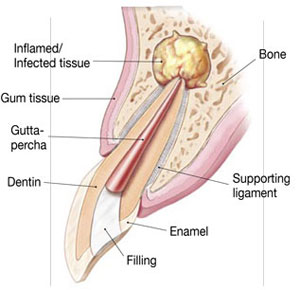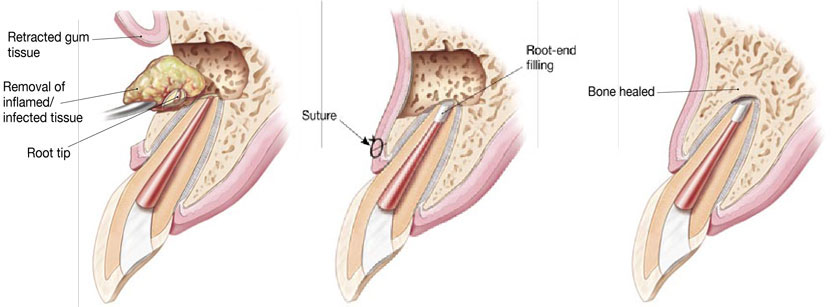





Endodontic Surgery (Apicoectomy)
 Generally, a root canal is all that is needed to save teeth with injured pulps from extraction. Occasionally, this non-surgical procedure will not be sufficient to heal the tooth and your endodontist may recommend surgery. Endodontic surgery can be used to locate fractures or hidden canals that do not appear on x-rays but still manifest pain in the tooth. Damaged root surfaces or the surrounding bone may also be treated with this procedure. The most common surgery used to save damaged teeth is referred to as an apicoectomy.
Generally, a root canal is all that is needed to save teeth with injured pulps from extraction. Occasionally, this non-surgical procedure will not be sufficient to heal the tooth and your endodontist may recommend surgery. Endodontic surgery can be used to locate fractures or hidden canals that do not appear on x-rays but still manifest pain in the tooth. Damaged root surfaces or the surrounding bone may also be treated with this procedure. The most common surgery used to save damaged teeth is referred to as an apicoectomy.
An incision is made in the gum tissue to expose the bone and surrounding inflamed tissue. The damaged tissue is removed along with a small amount of the root tip. A filling is placed in the end of the root to prevent reinfection then the gum is sutured. The bone naturally heals around the root over a period of months.
Following the procedure, there may be some discomfort or swelling while the incision heals. This is normal for any surgical procedure. To alleviate any discomfort, an appropriate pain medication will be prescribed. If you have pain that does not respond to medication or you experience signs of an infection, please call our office. We routinely see our surgery patients within 1 week to remove the sutures.

Home | Patient Information | Instructions | Dental Anxiety & Sedation | Procedures | Meet Us| Online Forms | Referring Doctors| Contact Us |Disclaimer | Site Map
Mark R. Jensen, D.D.S. • Susan G. Penniston, D.D.S., M.S. • Bradford J. Pugh, D.D.S. • Matthew G. Del Mastro, D.M.D. • Philip J. Wadsworth, D.M.D.
3401 Hwy 169 N, Plymouth MN 55441 • Phone: 763-559-0859 Fax: 763-559-4356
12000 Elm Creek Blvd., Suite 240, Maple Grove, MN 55369 • Phone: 763-416-3619 Fax: 763-416-3695
3905 Silver Lake Road, St. Anthony, MN 55421 • Phone: 612-248-8330 Fax: 612-315-5378
Endodontic Website Designby PBHS 2012©
